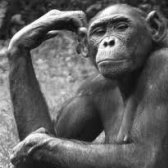By Jeff Meldrum
https://beta.capeia.com/zoology/2017/10/20/on-the-plausibility-of-another-bipedal-primate-species-existing-in-north-america
As I knelt beside the 38 cm footprint, one of several dozen distinctly impressed in the muddy side road in the foothills of the Blue Mountains of southeastern Washington, the hair literally stood up on my neck with the incredulous sensation that a sasquatch may indeed have passed by here just hours earlier. The clarity of detail and dynamic signatures left no ambiguity, no room for misidentification. These footprints were either a very clever hoax or the track of an unknown living creature. The spontaneity, variation and animation of the footprints tipped the scales decidedly in favor of the latter option. But what were the implications of that conclusion? As a budding physical anthropologist, I had essentially shelved my youthful curiosity about Bigfoot and assumed that the passage of decades without any physical evidence justified a skeptical indictment of the subject as nothing more than folklore and legend. Here, on an overcast afternoon in February 1996, was stark evidence to the contrary. Of course it was not definitive, as in the form of a specimen, a type to establish conclusively the existence of a novel hominoid species. And short of that, I was to learn, there was no accommodating by the anthropological discipline of even the proposition of such a species, regardless of the accumulating affirmative evidence.
It is one matter to address the theoretical possibility of a relict species of hominoid in North America, and the obligate shift in paradigm to accommodate it, but there must also be something substantial to place within that revised framework. There must be essential evidence to lend weight to the hypotheses, and counter the critics’ various aspersions. I was once confronted by a colleague, who declared, “After all, these are just stories.” My response: “Stories that apparently leave tracks, shed hair, void scat, vocalize, are observed and described by reliable experienced witnesses. Hardly just stories.” Others mock the notion as “pseudoscience,” but fail to explain their justification for that label, let alone provide a defensible rationale for their pat disqualification of the evidence at hand. Then there is the now popularized statement by ideological skeptic Michael Shermer, which eventually became the basis of a column in Scientific American, 2003 – “The science starts once you have a body.” On the contrary, most serious investigators would contend that the science starts once you have a question, followed by observation, and the accumulation of data. Each of these detractions begs the question of evidentiary substance that motivates investigation, and instead either off-handedly dismisses all evidence, or demands conclusive proof up front, a priori. That is hardly the method or process of explorative science.
Many remain skeptical of the premise simply due to what they assume to be an exceptionally low probability that such creatures could remain undetected and unacknowledged today by modern science, especially within the continental United States. It has been pointed out that there is no history of known hominoids in North America. Indeed the original primates to have ever inhabited North America were squirrel-sized to cat-sized Eocene prosimian primates, most closely related to modern lemurs and lorises, not apes or hominins . South and Central America would subsequently be colonized by platyrrhine primates, a diverse radiation now represented by marmosets to spider monkeys.
-------------------------------------------------------------------------------------------------------------
Further discussion in the article:
What would be the source of a giant relict hominoid in North America?
Why is there no fossil record of sasquatch in North America?
Where are any recent physical remains?
How would a relict hominoid make a living in a temperate forest habitat?
Footprint evidence
And more, in the article by Dr. Meldrum. Enjoy!

